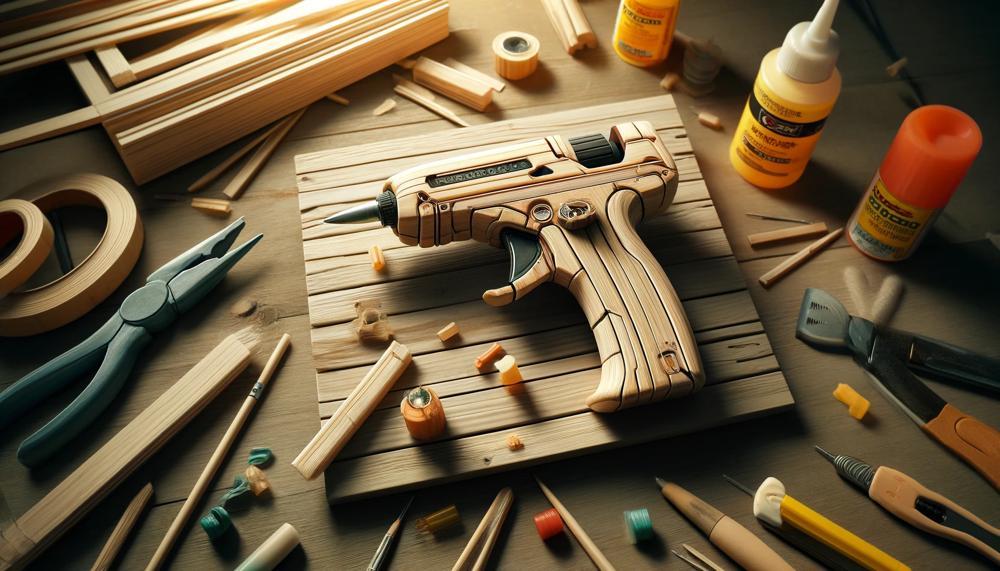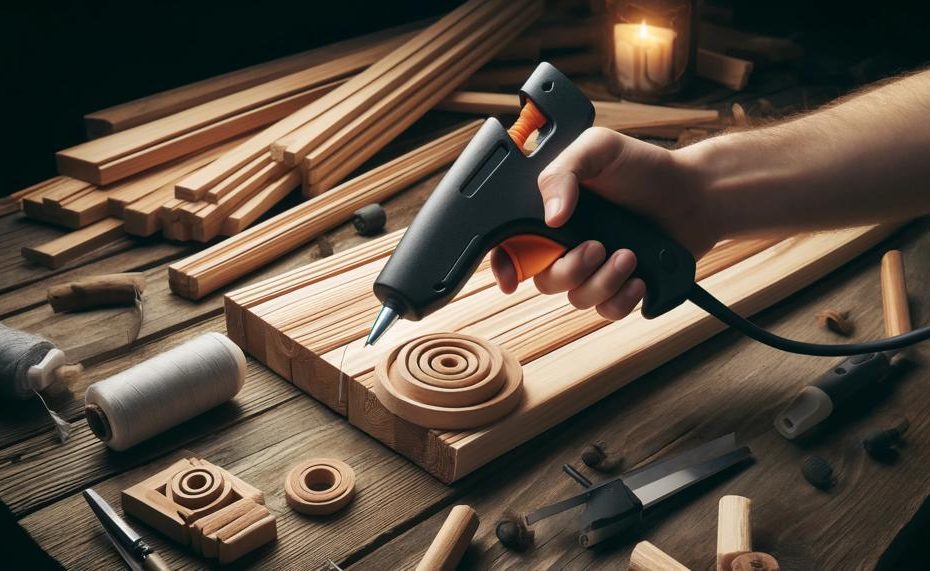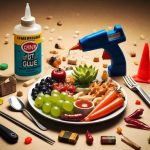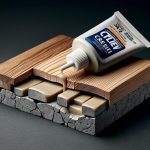An overwhelming majority of DIYers (around 80%) carry a hot glue gun. This seemingly small instrument can be used for more than just crafts; it can also work wonders on wood. Hot glue, when used correctly, has surprising capabilities: it can join wood, mend cracks, and simplify intricate woodworking processes.
Since most people connect hot glue with weak and flimsy wood joinery, this discovery usually comes as a shock to many.

The rapid bonding and moderate stress tolerance of hot glue make it a versatile tool for woodworking jobs, whether you need a temporary hold or a fast remedy. Even though it gives a quick hold, hot glue can’t compare to the durability and sturdiness of wood glue or epoxy in the long run.
So, can hot glue gun be used on wood?
Yes, a hot glue gun can be used on wood. Hot glue is incredibly useful for adhering two pieces together, whether they are porous or non-porous surfaces. It’s excellent for quick fixes, crafts, small DIY projects, and temporary solutions.
Here are some tips for using hot glue on wood:
- Choose a hot glue gun with a high wattage and a system that includes a heat sink and a plane iron.
- Choose a hot glue stick that matches the color of the wood or is darker, and has a high melting temperature.
- Apply the hot glue to the voids, defects, and knots in the wood, and press it down with the heat sink to make it cool and flat.
- Cut off the excess glue with the plane iron, and sand it smooth.
- Add some bark or other elements to the glue to create more natural features, and reheat and reshape the glue if needed.
Join us as we delve deeper into the dos and don’ts of using hot glue on wood, ensuring your projects hold together beautifully, even if temporarily.
Table of Contents
- 1 Advantages of Using Hot Glue on Wood
- 2 Disadvantages of Using Hot Glue on Wood
- 3 Factors to Consider Before Applying Hot Glue on Wood
- 4 Cleaning and Preparing the Wood Surface
- 5 Applying the Hot Glue to the Wood Surface
- 6 Heat Resistance of Different Types of Wood
- 7 Testing the Hot Glue Before Use
- 8 Conclusion
Advantages of Using Hot Glue on Wood
Hot glue boasts several distinct advantages when used for bonding wood, compared to other adhesives. Below is a detailed breakdown:
| Feature | Hot Glue | Other Adhesives |
| Versatility | Adheres to wood and a wide array of other materials like fabric and plastic. | Typically specialized for specific materials; less flexible. |
| Setting Speed | Sets within seconds, enabling rapid continuation of work. | Often requires clamping and longer setting times, slowing down progress. |
| Cleanup | Excess can be peeled off easily; minimal residue left behind. | Cleanup can be laborious and may involve solvents. |
| Accessibility | Glue guns and sticks are cost-effective and readily available in stores. | Can be more expensive and might not be as readily available. |
| Instant Bond | Provides an immediate hold, ideal for quick fixes and crafts. | Delayed bonding which may not suit rapid assembly or temporary fixes. |
Detailed Analysis:
- Versatility: Unlike many wood-specific glues, hot glue isn’t limited to one material, which simplifies the workspace and reduces the need for multiple adhesives for different types of projects.
- Fast-drying: The quick setting of hot glue significantly accelerates project timelines. While wood glues and epoxies might offer stronger bonds, they often necessitate prolonged drying times, which isn’t ideal for swift project turnovers or when holding pieces in place is impractical.
- Easy cleanup: One of the more frustrating aspects of using adhesives like epoxy or polyurethane is their messy cleanup, requiring chemicals or sanding once cured. Hot glue’s easy peel-off nature makes post-project cleanup a breeze, leaving behind a clean work surface.
- Affordable and accessible: For hobbyists or casual DIYers, the low cost and wide availability of hot glue guns make them an attractive option. This accessibility allows for spontaneous crafting and repair work without the need for significant investment.
- Instant bond: In situations where a quick fix is needed, hot glue is superior. Its ability to bond instantly is particularly useful in crafts and small-scale wood repairs, where holding components firmly and immediately can be crucial.
Disadvantages of Using Hot Glue on Wood
While hot glue is often hailed for its rapid bonding and ease of use, particularly in crafting and quick repair scenarios, several disadvantages specifically impact its effectiveness and safety when used with wood:
| Disadvantage | Explanation | Impact |
| Weak Structural Integrity | Insufficient for load-bearing applications | Limits use in structural woodwork |
| Thermal Sensitivity | Loses adhesion in heat | Possible joint failure in warm conditions |
| Incompatibility with Finishes | Does not absorb stains or finishes | Leads to uneven wood finishing |
| Durability Concerns | Becomes brittle over time | Reduced longevity and performance |
| Potential for Damage During Application | High heat can damage wood surfaces | Risks scorch marks or burns on wood |
| Difficulties in Repairs | Hard to remove or adjust once set | Complicates alterations and fixes |
Factors to Consider Before Applying Hot Glue on Wood
| Risk or Damage | Description | Prevention/Minimisation |
| Burns | Hot glue can reach temperatures of over 180°C. If it contacts your skin, it can cause burns leading to redness, blistering, and swelling. | Use a glue gun with temperature control and always wear protective gloves. Work in a well-ventilated area and keep first-aid supplies nearby for quick treatment. |
| Allergic Reactions | Some individuals may be allergic to certain components in hot glue, leading to skin irritation, rashes, or respiratory issues. | Test a small amount of hot glue on your skin before prolonged exposure. If there’s any sign of irritation, avoid using that glue. Wear a mask and gloves to minimise contact. |
| Skin Irritation | Even if you’re not allergic, prolonged exposure to hot glue can cause skin dryness, itching, or peeling. | Keep contact with hot glue to a minimum. Use a heat-resistant work surface and avoid touching the glue directly. Wearing long sleeves can also help protect against irritation. |
| Fire Hazards | Hot glue guns can overheat or short circuit, posing a fire risk, especially when left unattended. | Choose a high-quality glue gun with safety features, such as an automatic shut-off. Unplug the glue gun when not in use, and don’t leave it unattended while hot. |
| Wood Damage | Hot glue can create uneven surfaces on wood, and removing it might cause damage, especially with delicate wood types. | Apply hot glue carefully, and use sparingly to avoid excess build-up. When removing hot glue from wood, use a heat gun to soften the glue first to minimise damage. |
Cleaning and Preparing the Wood Surface
Cleaning and preparing the wood surface before using a hot glue gun is essential to ensure a strong bond and prevent imperfections.
| Step | Description | Tools/Materials Needed |
| 1 | Sand the wood to remove rough spots, splinters, or imperfections. This creates a smoother surface for glue adhesion. | Sandpaper (medium to fine grit), sanding block, or electric sander |
| 2 | Remove dust and debris with a tack cloth or a vacuum. This step is critical to avoid contamination, which can weaken the glue bond. | Tack cloth, vacuum with a brush attachment |
| 3 | Clean with mild detergent and water. This removes any oils, residues, or dirt. Use a soft cloth or sponge to avoid scratching. | Mild detergent, warm water, soft cloth or sponge |
| 4 | Rinse and dry thoroughly. Ensure no soap residue is left on the wood, as it can interfere with glue adhesion. Let the wood dry completely before moving to the next step. | Clean, damp cloth for rinsing, dry cloth for drying, or air dry |
| 5 | Strip old stains or finishes if needed. If the wood has existing stains or finishes, use a wood cleaner or stripper to remove them. | Wood cleaner or stripper, protective gloves, eye protection |
| 6 | Sand again to smooth out any raised grain caused by the cleaning or stripping process. This ensures an even surface for glue application. | Fine-grit sandpaper or sanding block |
| 7 | Final wipe down with a clean, damp cloth to remove any remaining dust or residue. This prepares the wood for glue application. | Clean, damp cloth |
Following these steps will help ensure that your wood surface is clean, smooth, and ready for hot glue.
Applying the Hot Glue to the Wood Surface
Applying hot glue to a wood surface may seem like a simple task, but it requires precision and technique for the best results. To properly apply hot glue to a wood surface, follow these steps:
- Prepare your workspace: Before starting any hot glue project, it is essential to have a clean and organized workspace. Lay out all the materials you will need, including the hot glue gun, glue sticks, clamps or holding materials, and the wood surface. This will help you work efficiently and avoid any unwanted mess.
- Master hot gluing techniques: To achieve clean and successful results, it is important to master some basic hot gluing techniques. These include holding the glue gun at a 45-degree angle, applying consistent pressure on the trigger to control the amount of glue, and moving slowly and steadily to create a smooth line of glue.
- Apply the glue quickly and efficiently: Hot glue dries quickly, so it is important to work quickly and efficiently. Start by applying a small amount of glue onto the wood surface and then use the tip of the gun to spread it evenly. Avoid using too much glue as it can create a mess and weaken the bond.
- Use clamps or holding materials: To ensure a strong bond, use clamps or holding materials to secure the project in place while the glue dries. This will prevent any movement and allow for a clean finish.
- Work slowly and steadily: As mentioned before, working slowly and steadily is key in hot gluing. Allow the glue to melt and flow onto the surface evenly without rushing or creating air bubbles.
- Choose the right type of hot glue for wood: Not all hot glues are suitable for wood surfaces. Make sure to choose a high-temperature hot glue specifically designed for wood. Also, sanding the wood surface before gluing can improve adhesion.
- Use just enough glue: Using too much glue can create a mess and weaken the bond. Use enough glue to create a strong bond, but avoid excess.
Heat Resistance of Different Types of Wood
When using a hot glue gun on wood, the heat resistance of different wood types significantly impacts the adhesive process and the durability of the resulting bond.
The table below compares how various woods respond to the heat from hot glue guns based on their heat resistance characteristics:
| Wood Type | Heat Resistance | Effectiveness of Hot Glue Bond |
| Oak | High | Excellent bond strength due to wood’s ability to withstand higher temperatures without degrading. |
| Mahogany | High | Good bond strength, similar to oak, suitable for projects requiring a durable bond. |
| Pine | Low | Reduced bond strength; susceptible to heat damage which may compromise glue effectiveness. |
| Cherry | Medium | Moderate bond strength; adequate for general use but not for high-stress applications. |
Testing the Hot Glue Before Use
To effectively test hot glue before applying it to wood, follow these practical steps to ensure the bond quality and durability:
- Surface Preparation: Clean the wood surface thoroughly to remove any dust, grease, or contaminants that could weaken the glue’s adhesion.
- Application Method: Apply a small amount of hot glue to a discreet area of the wood. Choose an area that reflects the wood’s typical surface texture, whether smooth or lightly sanded.
- Curing Time: Allow the glue to cure fully according to the glue gun manufacturer’s instructions, typically a few minutes, to assess the strength of the bond.
- Testing Bond Strength: After the glue has hardened, gently test the bond by applying a moderate force. The glue should hold firmly without cracking or peeling away from the wood surface.
- Assessing Removability: If necessary, check how easily the glue can be removed from the wood without damaging it. This is crucial for projects where temporary bonds are desired.
- Final Inspection: Examine the glue for any signs of inappropriate melting or poor adhesion, which could indicate unsuitability for your specific wood type or project.
Conclusion
As our exploration reveals, hot glue guns emerge not merely as simple crafting tools but as versatile assistants in the woodworking realm. Nearly 80% of DIY enthusiasts treasure this tool in their arsenal for its ability to swiftly bond wooden pieces, address imperfections, and even aid complex woodworking tasks.
This resourcefulness stems from hot glue’s rapid bonding capability and moderate stress tolerance, which commend it for quick fixes or as a temporary solution in larger projects.
However, it’s pivotal to grasp that hot glue, despite its immediate utility, does not match the enduring strength and reliability offered by wood glue or epoxy. Before using hot glue, ensure the wood surface is pristine to optimize adherence. Also, allowing the glue to set fully is crucial for a secure bond.
Hot glue’s budget-friendly nature and ease of use make it an appealing choice for casual projects. Yet, for endeavors demanding robust durability, combining it with more traditional wood adhesives can enhance strength.






